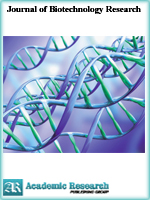Journal of Biotechnology Research
Online ISSN: 2413-3256
Print ISSN: 2413-8878
Print ISSN: 2413-8878
Quarterly Published (4 Issues Per Year)

Archives
Volume 6 Number 2 February 2020
Chemical Composition and Nutritive Parameters of Maize Stover (Zea Mays) Fractions and Cassava (Manihort Esculanta) Foliage for Sustainable Ruminant Production
Authors: Lamidi A. A. ; Joseph O. O.
Pages: 7-11
DOI: doi.org/10.32861/jbr.62.7.11
Abstract
Chemical composition and nutritive parameters of maize stover (Zea mays) fractions and cassava (Manihort esculanta) foliage for sustainable ruminant production was studied. Cassava foliage and fractions of maize stover (stem and leaf) were gathered and oven dried for proximate composition, fibre fractions and nutritive parameters (Dry matter intake (DMI), Digestible dry matter (DDM) and Relative feed value (RFV) were calculated. The experimental design was a completely randomized design (CRD). Results shows a significant difference (P<0.05) in the all the parameters considered for the proximate composition across the experimental treatments. The contents ranged from 85.21 – 88.77% for dry matter (DM), 6.27 – 19.72%, 1.89 – 3.78%, 14.89 – 17.08%, 51.88 – 62.47%, 3.27 – 11.23% and 36.90 – 56.70% for crude protein (CP), ether extract (EE), crude fibre (CF), neutral detergent fibre (NDF), ash and non-fibre carbohydrate (NFE), respectively. Cassava foliage had highest (P<0.05) contents of fibre fractions considered. The acid detergent fiber (ADF), acid detergent lignin (ADL), cellulose (CEL) and hemicellulose (HEM) were 59.18%, 18.36%, 26.50% and 27.10%, respectively for CSL. There was a significant different (P<0.05) in the phytochemical contents across the experimental materials. Similar (P>0.05) value was recorded for DMI, DDM and RFV. Conclusively, the experimental treatments exhibited nutritional qualities that made them a feed resources for ruminant production. Cassava foliage had better proximate composition and fibre fractions, therefore it is recommended for the farmers.



